How to See the Liberty Bell...in Queens
A copy of the famous American bell can be found inside a bank, which itself is modeled after Independence Hall!


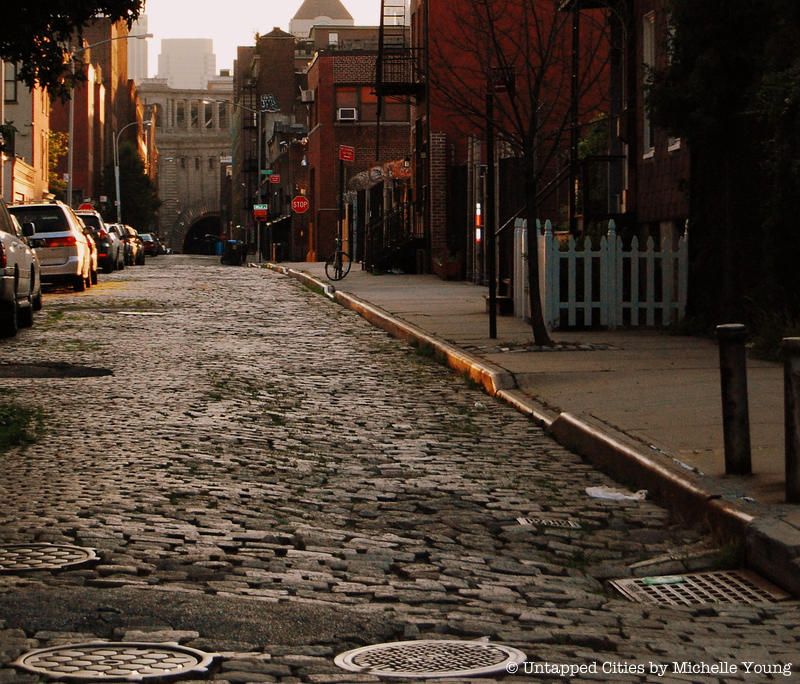
Ah, that iconic New York City cobblestone. Well, technically, as die hard New Yorkers are keen to correct, it’s known as Belgian block. The Historic Districts Council (HDC) recently a study on New York City’s Belgian block heritage, in the context of providing policies towards a more accessible historic streetscapes.
Here are 10 fun facts from the report about this historic paving in New York City:
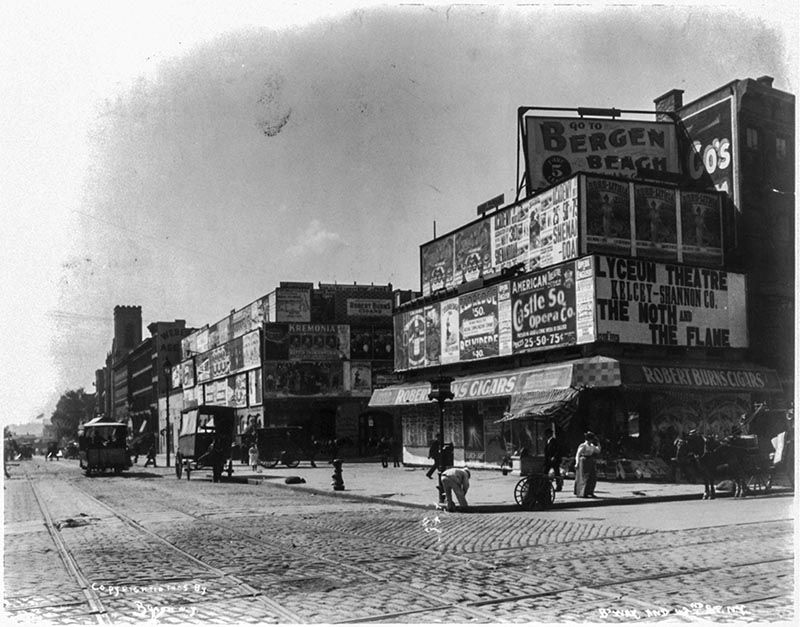
Belgian block on Broadway and 42nd Street, now Times Square, between 1898 and 1900. Photo from Library of Congress.
Although there is Belgian block in New York City that supposedly dates to the Revolutionary War, such as on Clove Road in Brooklyn (featured in Untapped Cities’ recent book Secret Brooklyn: An Unusual Guide), most of this type of historic pavement dates to the 19th and 20th Century, writes the HDC. The organization also attests that “what’s under foot matters,” and that “amid the ongoing work of protecting and celebrating civic heritage, paving materials, so often neglected, deserve their due as irreplaceable historic assets.”
At the same time, the organization recognizes that the mobility needs of today are drastically different from that of the 19th and 20th centuries, which was dominated by travel by horse-drawn carriage and street car. Today, pavement must accommodate a “new influx of local residents and modes of transportation necessary to create a walkable, bikeable, sustainable city of the 21st century,” attests the HDC.
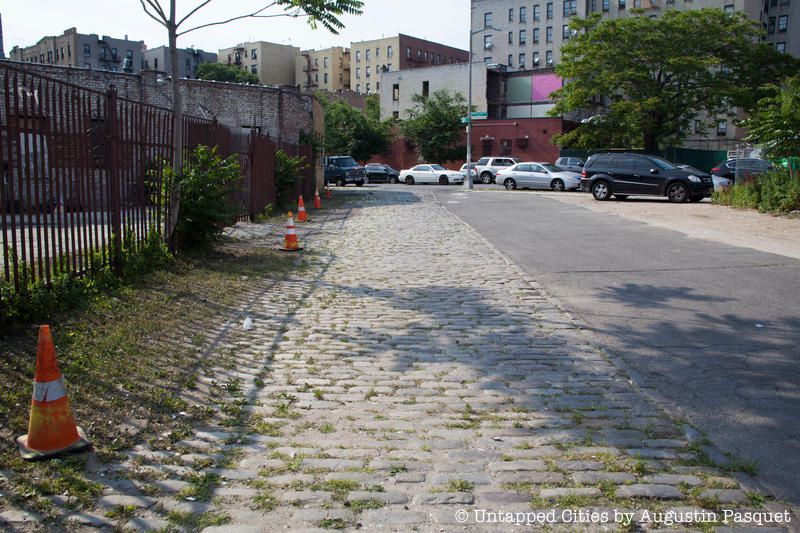
Belgian block on Clove Road in Crown Heights, Brooklyn
Though commonly used interchangeably in colloquial speak, cobblestone is an earlier pavement method that uses “untooled, naturally rounded stones,” whereas Belgian block is usually tooled granite in rectangular shapes. The HDC writes that cobblestone was used generally up to 1860.
From a physical and geological perspective, Belgian blocks were much more resilient than cobblestones. The HDC writes, “Belgian blocks were hard, durable, and offered a much smoother and more regular surface than cobblestones—’a very solid and impervious roadbed,’ according to an 1895 report in The City Record. Such qualities made them particularly suited for use along waterfronts and other areas with heavy commercial traffic.”

In 1949, Manhattan still had 140 miles of Belgian block streets. Today, there remains at most 15 miles. Areas of New York City where the Belgian block is concentrated at South Street Seaport, in Tribeca, SoHo, and Greenwich Village in Manhattan; and Brooklyn’s Fulton Ferry, DUMBO, and Vinegar Hill districts, and in Red Hook.
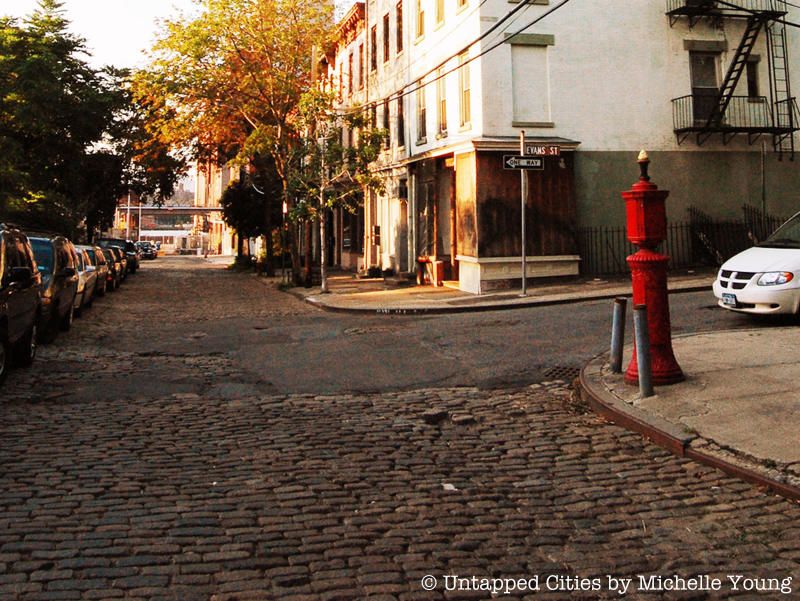
The HDC writes that “it remains unclear to what extent, and during what era, paving stones imported from Belgium may have provided the raw materials for New York City’s streets.” The type of paving stones originally known as Belgian block were six inch square traprock said to be used in Belgium. In the New York City area, this type of paving was sourced from the New Jersey Palisades. Introduced in 1852, and used generally after 1859, there are no known paving stones of this type today.
Rather, the current paving known as Belgian block was sourced from quarries in the northeast United States, and possibly other locations in the United States. One known quarry was in Vinalhaven, Maine, an active quarry today that also supplied the marble for the eagles of the original Penn Station.
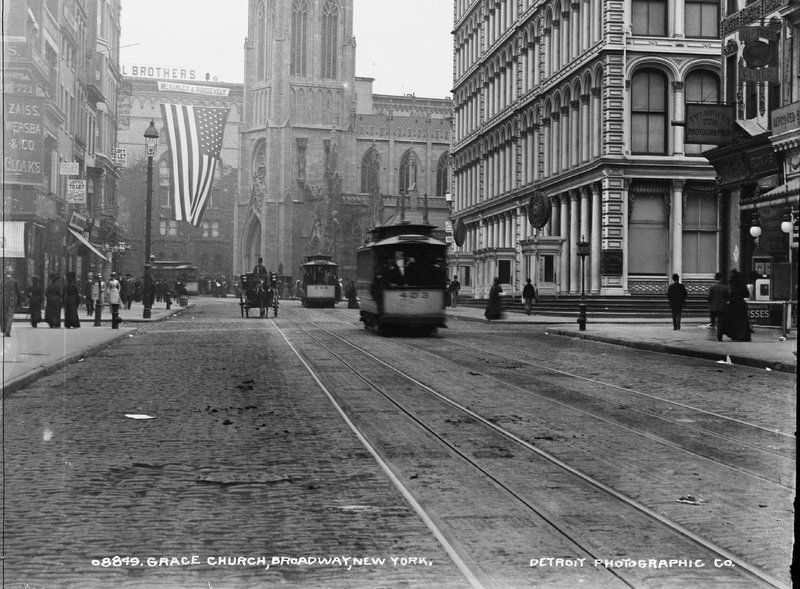
Broadway, circa 1900. Photo by Detroit Publishing Co., from Library of Congress
If you think back to the turn of the 20th century, a lot of intra-city freight transportation was still going by horse and carriage. The paving not only had to withstand quite a lot of traffic, it was even shaped to make it more convenient for horses and freight. The HDC writes, “By 1900, the stones used for such purposes were shaped to a relatively uniform width of between 4 and 5 inches, apparently proportioned to the size of a horseshoe. This allowed horses drawing heavy loads to secure a firm foothold in the joints between blocks.”
Today, the most common Belgian blocks in New York City are about 4 inches wide by 7 inches long – a type known as the “Manhattan standard” which date from 1912 to 1938. Another type of block, which was first utilized in the 1870s, is longer and can be up to 14 inches wide. The HDC writes that these blocks are “less regular overall, with rounded tops and generally wider joints between blocks.”
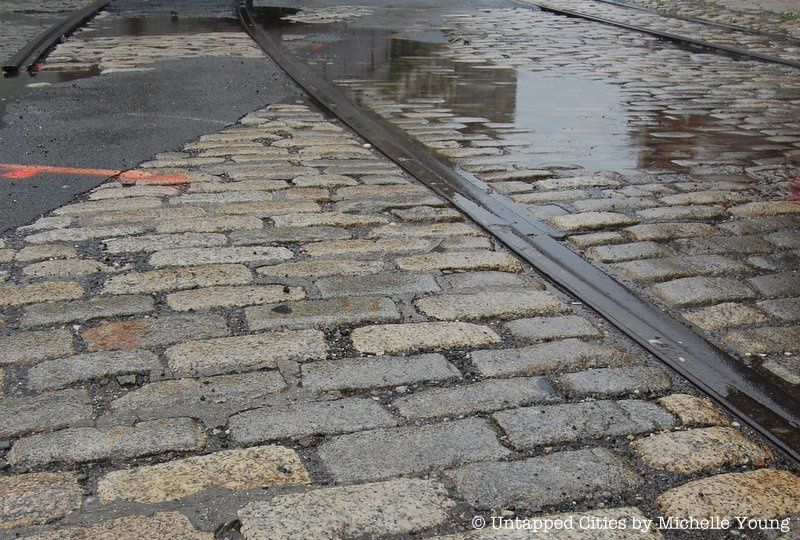
Worn down asphalt and Belgian block in Sunset Park, Brooklyn
We might love the look of Belgian block today, and the HDC in its study acknowledges that the stone evokes a sense “of the European character that pervaded the city’s early streetscapes and continues to contribute a distinctive sense of place today.” Nonetheless, the study finds that Belgian block started to get competition from asphalt even before the turn of the century: “By 1899, observers were deploring Belgian block’s ‘abominably rough surface and its propensity to get out of level.’ They were difficult to maintain, became slick when wet, and were rued as the noisiest pavement type.”
By 1890, the HDC reports, asphalt was used “extensively” for road beds and “within a decade had nearly surpassed granite in miles of Manhattan street coverage.”
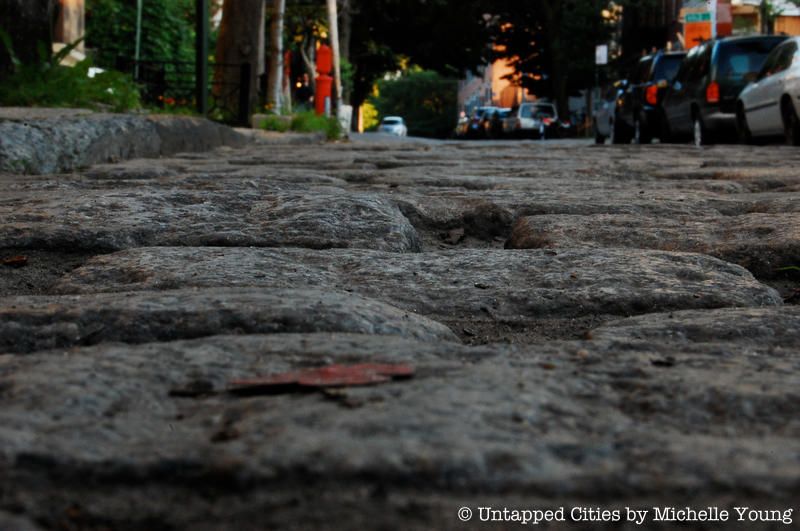
Belgian blocks in Vinegar Hill, DUMBO
In 1990, the Americans with Disabilities Act (ADA) and later updates mandated that “streets and sidewalks should be accessible for all who use them including those who use wheelchairs, walkers, or canes, or whose mobility otherwise depends on smooth, unobstructed surfaces,” writes the HDC.
The irregularity of Belgian blocks “makes them challenging for accessibility,” writes the HDC:
Because of their undulating shape, they often exceed the 1/4-inch vertical surface discontinuity standard. In addition, because the blocks vary in profile, it is difficult to lay them tightly enough together in such a way that transitions between blocks avoid non-compliant height variations and gaps. Like most historic granite pavements, these blocks are also not slip-resistant, particularly when wet, posing hazards to pedestrians and bicyclists. Due to these properties, most of DUMBO’s Belgian blocks unfortunately cannot meet ADA standards for accessible routes.
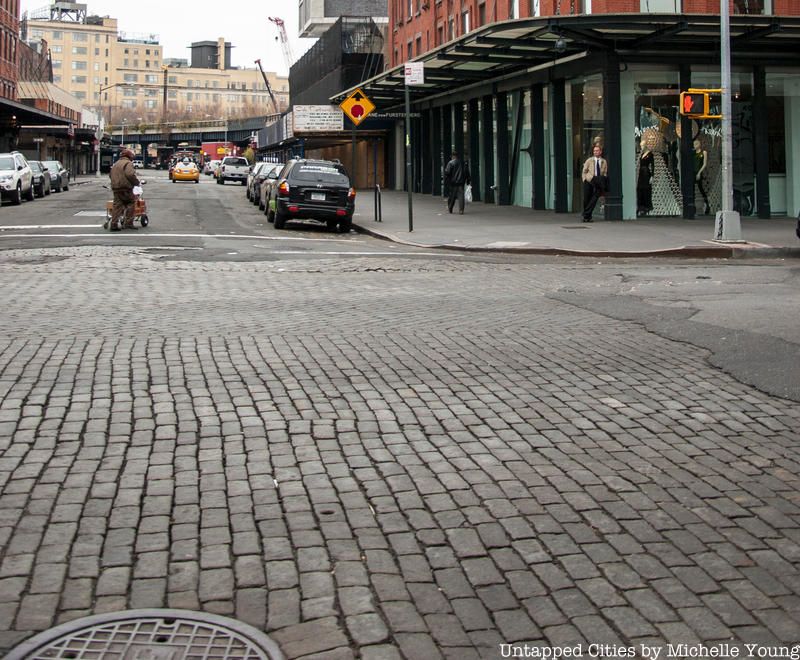
Meanwhile, there is hope for Belgian blocks in other neighborhoods. The HDC writes: “In the Gansevoort Market Historic District, it may be possible to bring existing granite blocks into ADA compliance in certain circumstances, due to the flatter and more uniform properties of the blocks in the Gansevoort district.”
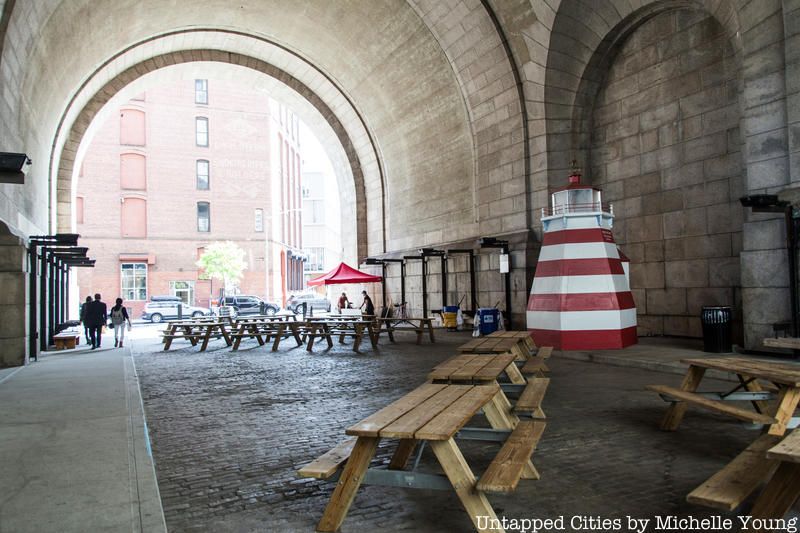
According to the HDC, “DUMBO’s streetscapes are marked by varying and highly unusual sidewalk conditions. …In [some] places, Belgian blocks are used for sidewalk paving, a detail not known to appear in any other New York City neighborhood.” Granite slabs are also present alongside Belgian block in DUMBO.

Eurocobble on Wall Street, with wooden markers that trace the original wall
In order to get streets and sidewalks up to ADA Compliance, many neighborhoods are replacing Belgian block with modern material bricks that replicate European paving styles. Central Park Conservancy, for example, is using a paver known as “Tumblestone,” and tumbling them together to give them a worn and rounded appearance, after which the stones are treated with a thermal finish for slip resistance.
On Wall Street, a material known as Eurocobble was used in a street renovation done in 2008-2010. Eurocobble is a preassembled cobblestone that can be created in pre-defined patterns and shapes and installed in a much more efficient manner, reducing costs on site.
See the full report on Belgian block from the Historic Districts Council.
Did you know some New York City streets and sidewalks were also made out of wood? See a remnant of New York City’s last wooden sidewalk here!
Subscribe to our newsletter